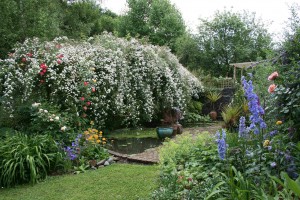
The sun shone, the clock struck two, we opened the gates and in they came; suddenly there was a steady stream of visitors walking round our garden on a beautiful June afternoon. They paused, sat in the sun, went round again. They loitered by the pond gazing at an avalanche of white, cascading “Seagull” intertwined with “Masquerade” drooping over the water.
Damsel flies hovered above Bobby’s huge water lilies. Towering delphiniums, hostas, geraniums swayed gently in the breeze.
Cream teas flew out of the kitchen; strawberry jam and delicious Devonshire clotted cream, donated by the Dartmouth Dairy, topped big fat scones made by the Anchorstone café. Friends rallied round to help.
We had done it again: for months and months we had dug, we had sown, we had weeded, planted, mowed, pruned and prayed for sun. And now after all the hard work the weekend had arrived; our garden teemed with happy smiling people. We sent off our biggest cheque ever to the National Garden Scheme to be divided once more between UK nursing charities.
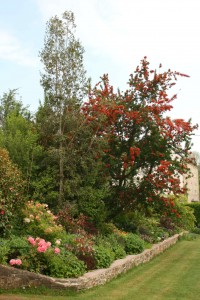
This year is our thirty second summer in the valley. It was February 1982 when our lives changed forever as we travelled west in search of lost friends. Not only did we find our friends but also fell in love with a poor old battered farmhouse. On the day of completion we arrived early and sat patiently on the grass wondering what on earth we had done. Eventually an old tractor trundled up and the farmer handed over a key; I gazed at it in wonder, just one enormous, rusty, unused old key; the key to our new life. Just then we were startled by the Red Arrows flying overhead, some welcome we thought, then realised it was Dartmouth Regatta week and the honour was not exclusively for us!

The house was built in 1767 by the local Rector for his daughter. Over the last two hundred and forty years it has been home to either churchmen or farmers. The Reverend Francis Lite, Poet and Priest of Brixham, lived here for a year or so before moving across the river. Maybe, we muse, he even wrote “Abide with Me” during his short stay here. The Deeds are lost so there is much we will never know but we do know that the family from whom we bought it had farmed here since 1922.
Our arrival was eventful. The removal lorry broke down on the motorway, and was, as I had predicted in several high decibel phone calls to the removal company, too big to fit through the narrow Devon lanes, too big to reach the house. All our belongings had to be decanted unceremoniously into a small hired van in the middle of the village right outside the shop; a good place for passers-by to get a look at the belongings and the people who had bought ”Dorothy’s House”.
Death watch beetle, wet rot, dry rot and flourishing fungi meant we had no floor boards on which to arrange this furniture. All our belongings, everything but the most basic necessities, had to be stacked high in the farm dairy. They would remain there for the next nine months. We began to forget about them; things we had deemed so essential simply weren’t missed. As the months passed I soon learnt that black mould is permanent and green mould can be brushed off…..
The dairy, now a cosy study, was a cold north facing addition, circa 1820. The deep slate shelves all round the room still remain. Each shelf has a gully which held a trickle of cold water that acted as the cooling system, keeping hams and cheese, milk and cream fresh; a nineteenth century “refrigerator”.
For months we all camped downstairs, sleeping on plastic covered mattresses. The children were ecstatic. They climbed around the house balancing precariously on the joists, exploring every corner and bagging a future bedroom each. They spent hours happily picking wet wallpaper of damp walls, they counted dead flies and compiled a scrap book of the amazing interior decoration. They recorded all details of yellow and orange staircase, pea green panelling in the little Georgian sitting room and the beautiful iron fireplace steeped in cream paint. They explored the overgrown garden and made camps in the orchard. They tramped across fields arriving home wet and muddy with happy exhausted dogs.
There was no hot water in the bathroom and the lavatory perched on high near the kitchen was inclined to give those brave enough to use it, a fairly substantial cold shower when flushed. Fortunately there was another one upstairs which was less eccentric, but journeying to it meant balancing on ceiling joists.
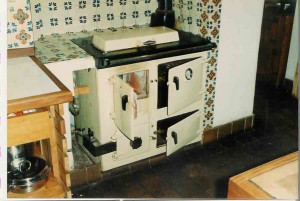
I loved the old solid fuel Rayburn. It stood cream and battered in the corner of the old kitchen. It hadn’t been used for years but it was the only source of heat we had. All the chimneys were blocked up either deliberately or by years of nesting birds. So to cook our food, give us a little hot water and keep us warm, I set about bringing it back to life. I scrubbed the old thing, bought some “nuts” to feed it and fired it up. If the wind was in the right direction it was a marvel. But, as the hills rise high behind the house, on grey days the smoke was returned unceremoniously down the chimney. It began to rule our mealtimes. Would it roar into life and cook lunch or would the cloud hanging heavy in the sky make us wait till supper time for the fire to draw.
The old kitchen had no sink or drainage of any kind. A modern breeze block extension housed a metal sink whose waste pipe ended in mid-air. Water flowed first onto the floor then trickled optimistically towards a little drain hole: sometimes it disappeared, sometimes it didn’t. It was a long, wet walk from cooker to sink with a saucepan. Cooking was a challenge.
In November the builders arrived and the restoration process began. The pantry vanished together with the waterfall loo. Suddenly a large space appeared which would in time become the new kitchen. Ceilings fell down, new ones replaced them. Heating and plumbing appeared; water, no water, heating, no heating. And, of course, things got so much worse before they got better.
Christmas approached and after much discussion we decided to make a valiant effort and celebrate in the shell which was to be our home. We hung a curtain across the bathroom door for Granny who whistled to indicate her occupancy; new floor boards in place made her journey slightly less hazardous.
Rubble was barrowed out of the kitchen, the floor was levelled. A shiny new sink appeared then taps, hot water. What more did I need! A Christmas tree acted as camouflage and a few decorations lit up the occasion.
The dear old Rayburn came up trumps and cooked a turkey to perfection. Chairs and table were pulled out of storage and dusted down. Table laid, crackers in place and friends and family sat down together for the traditional festive feast in somewhat unconventional surroundings. My father gave me a long look and asked if I thought we had been altogether wise. I just smiled.
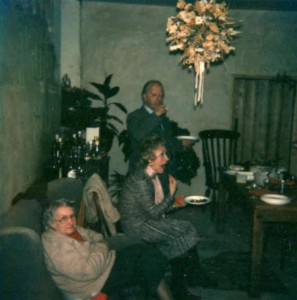
As months passed, we made progress. Paul returned to work in London saying “Now, don’t start taking the stair case to bits…” I made a plan with my new friends, the builders. Terry borrowed a pig trough from farmer Richard. I filled it with caustic soda and washing powder and we were in business. Terry dismantled the staircase piece by piece. I dipped each spindle into the pig trough and scraped, and dipped, and scraped and rinsed again until years and years of old paint was gone. I handed them one by one back to chippy Chris who reassembled everything. What a team! By the time Paul returned the job was done. Not a trace of orange or yellow paint anywhere.
Decorating next and along came “Les the Decorator”. We chiselled off the distemper and hosed down the stairs together, all three floors. As Les transformed each room I sat on the sitting room floor for days on end pickling and picking the paint from the cast iron fireplace. As I worked the beauty of the metalwork emerged. I was lost in admiration at the depth and detail of the design. Soon carpets arrived and curtains were hung and the wonderful team departed. Our worldly belongings emerged from the damp dairy and the house came to life once more. Best of all I had the most beautiful kitchen I could possibly have imagined.
Time now for garden restoration: as we cleared and dug, chopped and cleared, the basic structure of a garden long forgotten began to re-emerge. Someone at some time had cherished it.
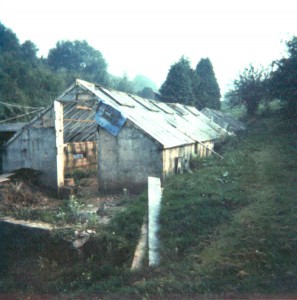
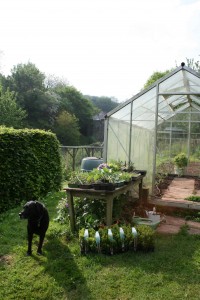
Down fell the derelict old green houses, broken glass threatening to chop off our heads. Down came the great tin tractor shed, in went the pond, out went the fencing made of gas stove and corrugated tin. In went banks of shrubs, out went broken outhouses and bindweed and dead trees.
In went roses and camellias, beech hedges. Up popped swathes of bulbs and wild flowers. Stifled for years beneath the undergrowth, they took their chance to break free at last.
Slowly, slowly a garden emerged once more in the valley.
And then one day, some years ago now, the County Organiser of NGS came to tea and suggested we open the garden for charity. “Weed, weed, weed” she said and I’ve been weeding ever since……………..
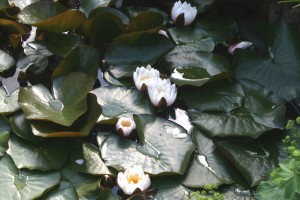
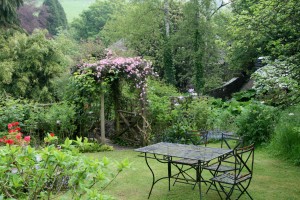
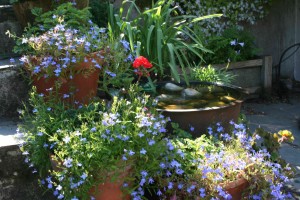

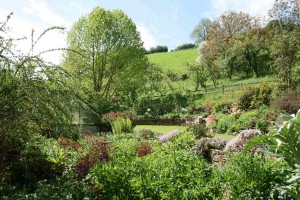
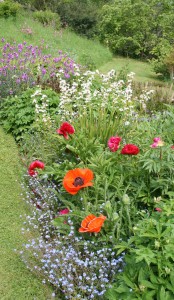
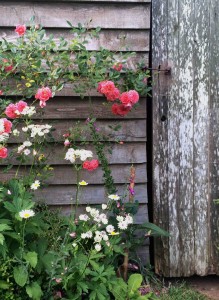
Leave a Reply